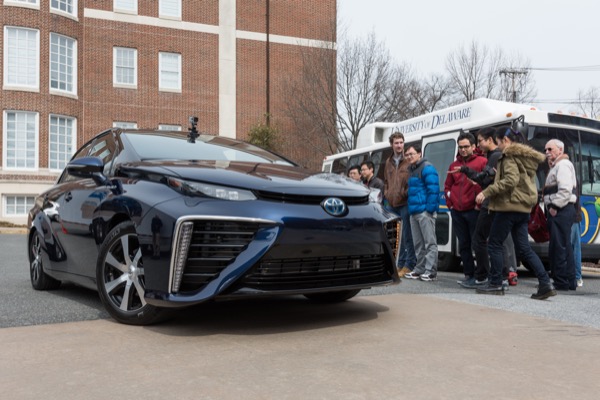Outreach tour for new Toyota fuel cell vehicle stops at UD
Sales of Toyota’s new fuel cell vehicle, Mirai, will begin later this year in California, where the infrastructure for hydrogen fueling already exists. But on Tuesday, March 16, University of Delaware faculty, staff and students got a sneak peak at the sleek sedan, whose name means “future” in Japanese.
According to Robert Wimmer, director of Toyota’s Energy and Environmental Research Group, the company selected UD for a stop on its Mirai Experience Tour because of the innovative research and development being performed at the Center for Fuel Cell Research (CFCR).
“The center’s work covers the entire spectrum from membrane and catalyst research to fuel cell vehicle operation,” Wimmer says. “This type of hands-on education provides students with the skills needed by industry and ultimately for fuel cell technology to succeed.”
Fuel cell technology has been implemented in UD’s campus shuttle bus service since 2007, with the fleet now including two hydrogen-powered fuel cell/battery hybrid buses that emit no harmful emissions. Two more fuel cell buses will be added to the fleet in 2015.
“Our goal is to educate the public that fuel cells are clean, safe and reliable and that fuel cell vehicles are easy to refuel,” says Ajay Prasad, CFCR director and College of Engineering Alumni Distinguished Professor. “Part of our work is to get the public ready for the coming fuel cell automotive revolution.”
Driving the research
Getting the public ready is just part of CFCR’s work, however. Efforts in the center are also aimed at improving the strength and durability of the polymer electrolyte membranes that lie at the heart of automotive fuel cells, as well as at addressing the challenges associated with developing the hydrogen infrastructure.
W.L. Gore and Associates, a world leader in fuel cell membranes, has supported the membrane research at CFCR.
“Fuel cell electric vehicles require light, powerful, reliable engines,” says Gore’s Simon Cleghorn. “We’ve been working on developing very strong and thin composite membranes that have enabled both very high power density fuel cell engines and long operational life.
“Over the past 10 years, we’ve collaborated with the Center for Fuel Cell Research in several areas,” he adds. “One of the most important has been working to understand mechanical failure modes in polymer electrolyte membranes.”
To address the infrastructure issues, center researchers are working with scientists from Air Liquide, a major producer and supplier of industrial gases that is on the forefront of hydrogen fuel cell technology.
“For fuel cell cars to become a reality, the challenges associated with developing the hydrogen infrastructure — including production, storage and delivery — will need to be resolved,” Prasad says. “We have conducted research on the renewable generation of hydrogen from sunlight as well as on novel strategies for improving the storage of hydrogen with solid-state hydride materials. Both of these efforts have involved collaboration with Air Liquide.”
From buses to cars
Prasad believes that a lot of the work done at CFCR is highly relevant to automotive fuel cells.
“We’ve conducted significant research and developed intellectual property in a number of areas including improved membranes, novel gas diffusion layers, cost-effective and durable catalysts, and improved balance-of-plant,” he says. “Some of the fuel cell products we’ve developed are actually being considered for implementation by major automotive OEMs.”
“I’m very glad that we were able to demonstrate this advanced vehicle on our campus,” he continues. “After decades of R&D and prototype development, fuel cell cars are finally on the threshold of commercialization. With the announcement of the Mirai, Toyota is one of the first companies to sell cars to the general public. It’s a major technological and commercial breakthrough and is very exciting to witness.”


